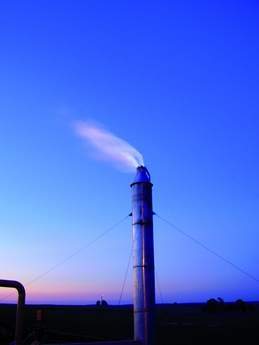So far so good at the pioneering Majuba underground coal gasification demonstration pilot project in Mpumalanga province, South Africa. Originally focused on providing syngas for co-firing in the existing Majuba coal fired plant, the proposal now under consideration is to also use the gas in a new CCGT plant to be built adjacent to the original power station.

Around the middle of 2008 the next major milestone will be reached at the Majuba underground coal gasification project when gas production is scheduled to be increased to 70 000 Nm3/y, from the current level of about 3000 Nm3/y. Extensive monitoring to date has provided positive results, while the gas quality has been good.
The Majuba project, which produced its first syngas in January 2007 (see MPS, March 2007, p3) – and has generated 100 kWe in a converted genset to prove the concept – was initially envisaged as a way of making use of a seam of coal originally intended to supply the 4200 MWe Majuba coal fired plant, but which turned out to be unmineable. The 3.5 m thick seam, at a depth of about 300 m, was found to suffer from frequent dolerite intrusions, causing the mine to be closed and requiring fuel for Majuba to be transported from distant mines, adding to costs.
The UCG plan at Majuba was to co-fire the syngas with coal in the power plant’s burners, but the new concept is now to primarily burn the syngas in a proposed new 6 x 350 MWe (2100 MWe) combined cycle plant. So the project amounts to a form of air blown IGCC, although of an unusual configuration.
The change of tack at Majuba, from a new source of fuel supply for the existing station to the possibility of building a new additional station, was prompted by the shortage of generating capacity that has become a problem in South Africa in recent years (with reserve margins down to 8-10%).
Eskom’s preliminary studies indicated very favourable costs for the 2100 MWe IGCC and development of this option is presently being considered by the Eskom approval committees and the National Energy Regulator.
The proposed IGCC scheme would achieve an efficiency of about 50%, compared with the existing coal station’s 36% and, according to Eskom, the UCG/CCGT combination has been identified by BHP Billiton (Australia) as being the “cleanest coal-based technology available at present, with only ultrasupercritical pulverised fuel technology offering a potentially cleaner option once commercialised.” Eskom thus sees UCG as supporting its “commitment to sustainable development.”
Nevertheless development of co-firing is still viewed as part of the project, which is currently regarded by Eskom as very much a research programme, and co-firing of the UCG syngas in one of the Majuba burners (6MWt) is planned for next autumn.
Co-firing will enable the ramp-up of gas production to the rather substantial quantity of syngas (about 630 000 Nm3/h) required for the first 350 MWe unit, scheduled to be in operation in 2012. Co-firing also has the potential to give the IGCC plant flexibility by absorbing gas from the UCG production (which prefers to run continuously) during a IGCC unit outage.
The project is using Canada-based Ergo Exergy’s eUCG technology (see MPS, June 2006, pp 15-16), which originated in the former USSR in the early 1930s and has been deployed in Australia and on several sites in the former USSR.
But the scope, scale, quality and pioneering nature of the project planned for Majuba is unparalleled. UCG technology is comparable to conventional longwall underground mining in concept, but of course very different in execution. UCG technology has been proven to provide very high coal extraction efficiencies, greater than 95%, while the overall resource extraction efficiency shows potential to far exceed that of conventional underground mining.
Eskom’s preliminary estimates show that there are about 45 billion tons of coal in South Africa (excluding coalfields in KwaZulu-Natal, Ermelo and Witbank) presently regarded as unmineable with currently available technologies, but suitable for UCG.
Other benefits mentioned by Eskom: there is no need to send people underground to dig up the coal and it is the safest method of coal extraction; capital and operating costs are comparable to traditional mining; and it relies on a gasification principle that has been practiced on the surface for nearly 80 years. The company also believes there are environmental advantages and cites, as an example of the environmental performance of UCG, the results of environmental monitoring over 1999-2004 at the Chinchilla UCG project in Australia. These include: no groundwater contamination; no ground subsidence; no surface contamination; controlled shutdown completed; and an annual independent audit showing full compliance with the environmental management plan and environmental regulations.

It works! Majuba underground coal gasification flarestack at sunset (the flame is an intense blue, not visible during the day). See also the photograph on the cover of this issue, which shows the flarestack, gas treatment plant and mobile gas analysis laboratory at the UCG site, together with an inset photograph taken on the occasion of first flaring of the syngas (20 January 2007)
June 2007 saw Ergo Exergy sign a technical alliance agreement with BP on UCG.
